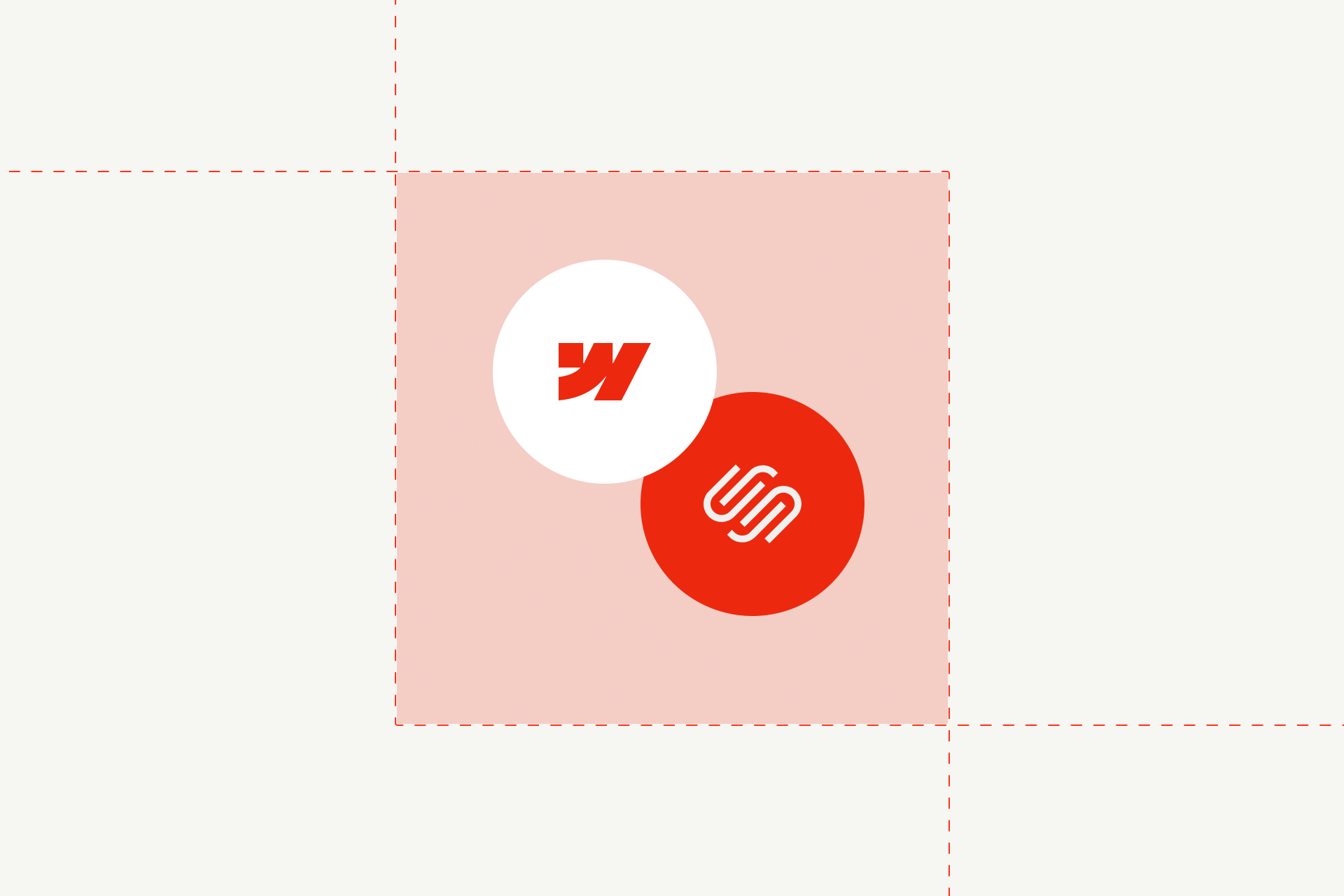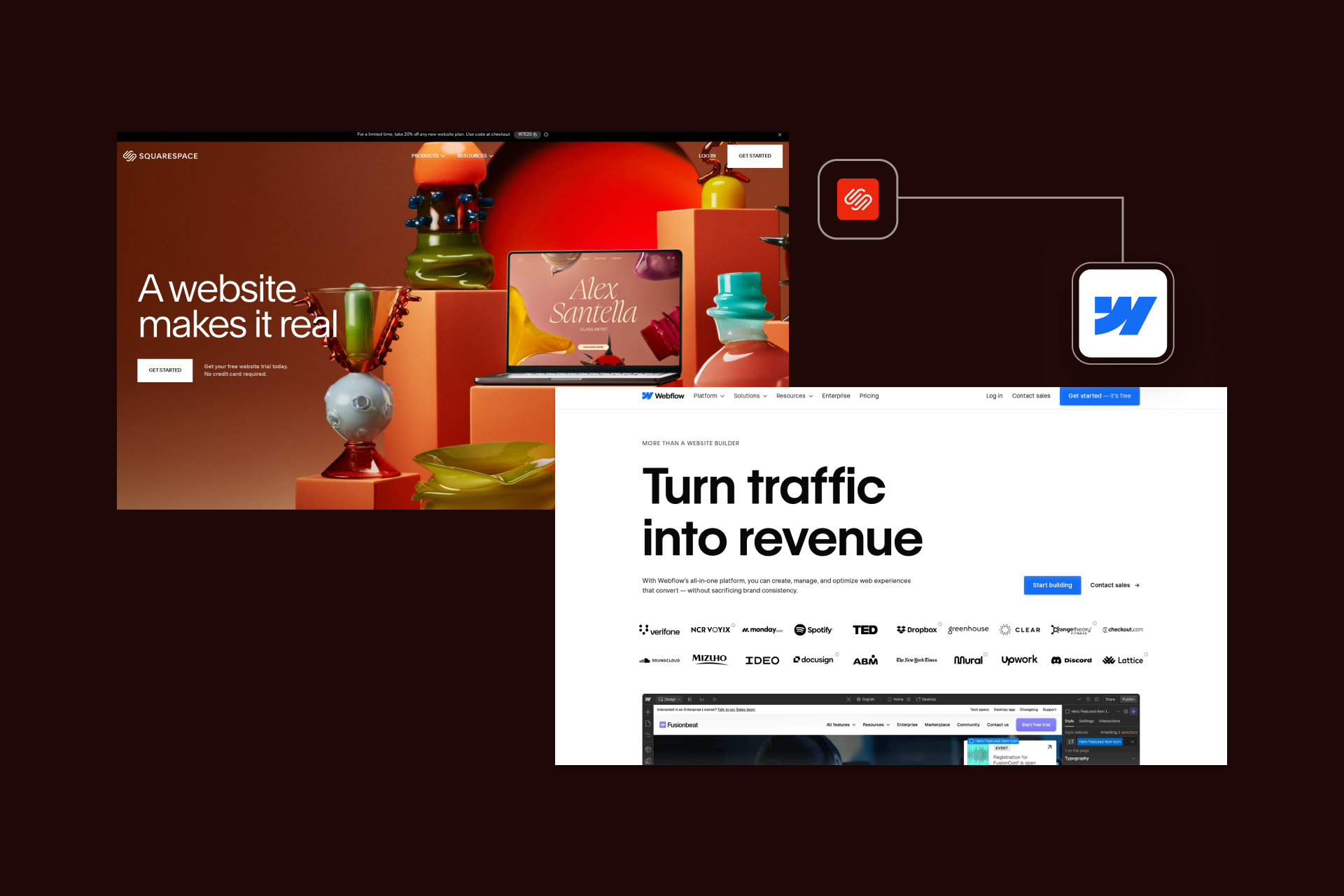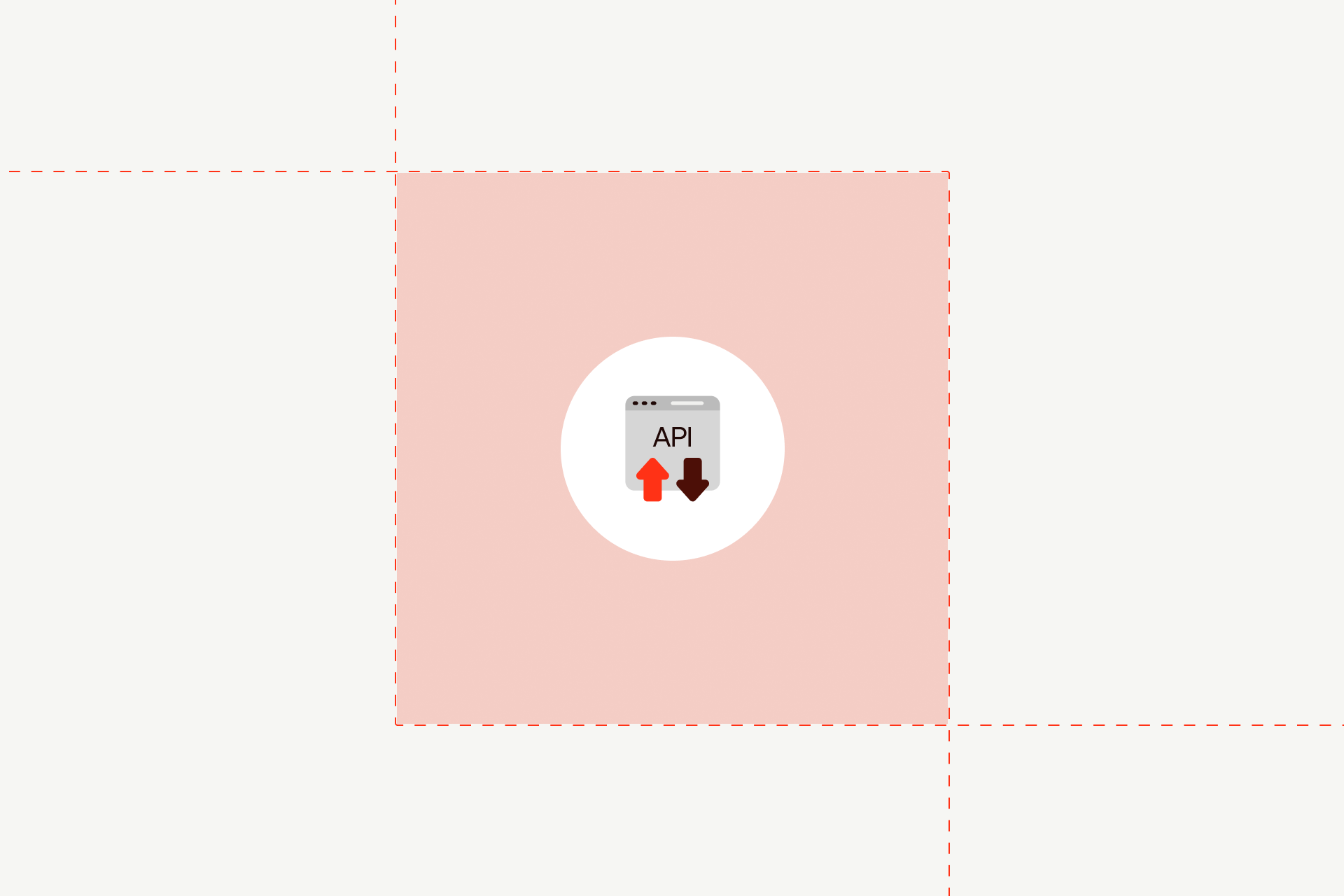Webflow vs. Squarespace: A Deep Dive

Webflow vs. Squarespace: What Actually Matters for Your Website

When you're choosing between Webflow and Squarespace, you shouldn’t just focus on which one looks better, has more templates or features.
The real question is: which platform can help your enterprise company grow smarter? Simply put, the platform you will choose for your website must fit the bigger picture and align with your strategy.
While both Webflow and Squarespace offer modern, powerful website-building options, they work in very different ways. So we will compare what they can offer in terms of control, speed, and customization.
Skip the Surface-Level Comparisons
Most website comparisons focus on the surface stuff and general features such as: how many templates you can find, what are available built-in tools, or add-ons, whether there’s a blog feature, and how polished the design interface looks. We can agree that this information is useful, but for leading companies it can miss the point.
If you're a fast-growing company, you care more about what’s under the hood:
- How much control do you really have?
- Can your marketing team make updates without always relying on developers?
- Does it scale smoothly as your needs grow?
Webflow gives you more flexibility and design freedom, with room for custom solutions when needed. On the other side, Squarespace offers simplicity and a streamlined experience, but with less flexibility in how deeply you can tailor things.
Key Summary: For Who Each Platform Is
When you're choosing between Webflow and Squarespace, you shouldn’t just focus on which one looks better, has more templates or features. The real question is: which platform can help your enterprise company grow smarter?
Simply put, the platform you will choose for your website must fit the bigger picture and align with your strategy.
While both Webflow and Squarespace offer modern, powerful website-building options, they work in very different ways. So we will compare what they can offer in terms of control, speed, and customization.
For Who Each Platform Is
Before jumping into key differences between Webflow and Squarespace, we need to determine who each platform is. It’s not a mistake if you use Webflow or Squarespace even if you don’t fall into the right category, but knowing what’s the best choice for your company can work better in the long run.
Squarespace is perfect for small, low-maintenance websites with minimal customization needs. In this category we usually see websites like personal portfolios, simple blogs, or small businesses websites primarily needing an elegant online presence without complex features.
Webflow is the best choice for teams who care about flexibility, performance, and long-term control, especially if working with developers, designers, or managing content. If advanced scaling, complex integrations and your brand identity must be a part of your online presence – Webflow remains the best fit.
Performance and SEO: Under the Hood, It’s Not Close
The right website platform depends on whether your business prioritizes raw speed and granular control over SEO. For basic online presence and foundational search traffic, many platforms offer solid out-of-the-box SEO and good performance.
But if your business needs high organic search visibility, fast loading times, or advanced optimization for AI-powered search, you'll require a platform that allows control over technical details and generates highly optimized code.
Webflow is known for generating minified, tree-shaken JavaScript with no unnecessary framework overhead, semantic HTML5 markup without excessive div nesting, and optimized CSS with automatic removal of unused styles. This results in typical bundle sizes 40-60% smaller than Squarespace's jQuery-heavy output, directly impacting Time to First Byte (TTFB) and parsing times. Webflow sites consistently achieve excellent scores on Google's Core Web Vitals (Largest Contentful Paint, Interaction to Next Paint, and Cumulative Layout Shift), which are crucial ranking factors in 2025.
This is partly due to Webflow's automatic image optimization with WebP conversion, lazy loading by default, and CSS-based animations that don't trigger layout shifts. Webflow's integrated hosting, powered by Amazon Web Services and Fastly, ensures ultra-fast loading times globally.
Furthermore, Webflow offers robust SEO flexibility. You have full control over meta tags, customizable URL structures, alt text for images, and advanced robots.txt configuration. Its clean code and ability to implement structured data and schema markup easily are vital for optimizing for both traditional SEO and the increasingly important Generative Engine Optimization (GEO) and Answer Engine Optimization (AEO) that AI-powered search engines prioritize in 2025.
Squarespace, while it has made strides in its built-in SEO features (like clean HTML structure, mobile responsiveness, and free SSL certificates), still operates with a more bloated underlying markup compared to Webflow. While it's capable for basic SEO, it lacks the advanced customization and granular control over technical SEO aspects that Webflow provides, which can limit your ability to compete for high-traffic keywords or manage complex site structures effectively as search evolves.
CMS and Scalability: One Grows With You

When choosing a CMS, the primary factor is how actively your content needs to function for your business. If your content is largely static or fits standard formats like blog posts and simple product listings, an easy-to-manage platform may suffice.
If you anticipate diverse content, complex internal content interactions, or scaling to thousands of unique items, you'll need a platform with a deeper, more customizable system to support your growth.
Webflow's Content Management System (CMS) is powerful and flexible and it allows you to build custom content structures which can power anything from blogs and events calendars to intricate directories and e-commerce product listings. The CMS supports up to 10,000 items per collection (20,000 on Enterprise), reference and multi-reference fields for relational data, conditional visibility rules, and a full REST API for headless implementations.
Collection lists can be filtered and sorted dynamically with up to 100 items displayed per page without pagination. This means you can create scalable content systems that grow with your business, allowing for dynamic filtering, searching, and custom layouts for different content types. In 2025, Webflow's CMS remains a top choice for content-driven websites looking for long-term growth.
Squarespace is perfectly fine for simpler content needs, a blog with a few dozen posts, a static informational website with 10-20 pages, or a basic online store. Its CMS is straightforward and easy to use. Squarespace is not built for the kind of complex, interconnected content systems that Webflow excels at. If your business anticipates significant content growth, requires custom content types, or needs to manage large databases of information, Squarespace will quickly become a bottleneck.
Third-Party Integrations and Control
When choosing a platform, consider your integration needs. If you prefer a streamlined, all-in-one experience with built-in core functions, a curated ecosystem will be comfortable.
If your business requires connecting to a specific set of external tools (like advanced marketing automation or complex CRMs), you'll need a platform offering a more open and extensible environment with broad integration freedom.
Webflow is built for seamless integration. It plays exceptionally well with a vast array of third-party tools via its native integrations, custom code embeds, and APIs. Whether you're connecting to marketing automation platforms like HubSpot and Marketo, CRM systems, analytics tools, payment gateways, or custom APIs for unique functionality, Webflow provides the flexibility to do so. This open approach allows businesses to experiment, automate workflows, and personalize user experiences on a deep level.
Squarespace is much more locked down. While it offers a selection of Squarespace Extensions (third-party tools for sales, marketing, inventory, etc.), the range and depth of integration are significantly more limited. This "walled garden" approach can constrain your ability to leverage specialized tools, automate complex processes, or integrate with bespoke internal systems, ultimately limiting your operational flexibility and innovation.
Dev/Team Workflow: Webflow Gives You Real Ownership
Consider your team's technical expertise and future needs. If your website is managed by one person or a small, less-technical team focused on simple content updates, a platform offering a user-friendly, collaborative experience will be ideal.
On the other hand, if you have a dedicated design and development team or plan to hire professionals who require pixel-perfect control, custom animations, and a modern web development workflow, another platform will provide the deeper control and "ownership" they need.
Webflow allows your team to work like a cohesive system. Designers can build visually, marketers can manage content directly within the CMS, and developers can jump in to add custom code or integrate with advanced systems where needed.
Webflow's robust version control, collaborative features, and the ability to export code (if desired) mean that your team retains real ownership and control over the website. This collaborative environment is ideal for companies with dedicated marketing, design, and development teams focused on scaling their digital presence.
Squarespace is more of a "set it and forget it" solution. It's excellent for freelancers, solo entrepreneurs, or small businesses where one person often manages the website.
The streamlined interface makes it easy to maintain, but it doesn't offer the same level of granular control or collaborative tools that facilitate complex team workflows. For companies with growth goals, compliance expectations, or a need for intricate internal processes, Squarespace's simpler workflow can become a limitation.
The Bottom Line: Choose Based on Where You're Headed
In 2025, the choice between Squarespace and Webflow boils down to your future aspirations.
If you're a solo consultant, or a small business just looking for a simple, elegant online presence with minimal ongoing customization, Squarespace is a perfectly viable and easy-to-use solution. It gets you online quickly and efficiently.
If your site needs to be scalable, perform exceptionally, offer maximum design flexibility, manage extensive content, integrate with a complex tech stack, or operate in a high-trust industry, Webflow is the more powerful and scalable long-term solution.
It's an investment in a robust digital foundation that can truly grow with your business and adapt to the ever-changing demands of the web.
Want to see how Webflow can empower your business's growth? Book a 30-minute discovery call with the Shadow Digital team! We'll help you determine your specific needs and align your strategy with the ever-changing digital landscape.
{{cta-card}}
FAQ
What is better, Webflow or Squarespace?
Webflow is better for fast-growing companies, marketing teams, and professionals who need full design control, advanced SEO capabilities, and a scalable CMS.
Squarespace is better for solo entrepreneurs, freelancers, and small businesses who just need a beautiful, low-maintenance site. It’s perfect for simpler needs, like portfolios, basic blogs, or informational sites where speed to launch and ease of use matter more than deep customization.
The final decision, however, should come down to your specific needs and long-term goals. Where are you headed, and how much control will you need as you grow?
What is the downside of using Webflow?
Webflow gives you power and flexibility, but with that power comes a learning curve. It’s not as plug-and-play as Squarespace, and non-technical users may initially feel overwhelmed by the interface or the idea of structuring content via a CMS. Also, while Webflow is incredibly extensible, more advanced features might require help from a developer. So if your team isn’t ready to work hands-on (or doesn’t want to), Webflow might be more than you need right now.
Do professionals use Webflow?
Yes. In fact, Webflow is often the go-to platform for professional designers, developers, and growing marketing teams who want pixel-level control, SEO performance, and scalable content systems. It’s especially popular with agencies, startups, and enterprise teams who need to move fast without compromising on quality or flexibility.
Do professionals use Squarespace?
Yes, but usually for simpler use cases. Freelancers, creatives, and small business owners often choose Squarespace because it offers a beautiful and efficient way to launch a site without coding. Some professionals even use it for client work when the brief calls for something clean and low-maintenance. That said, it’s not the top choice for professionals managing complex or high-performance sites.

Let's Build Your Webflow Website!
Partner with experts who understand your vision. Let’s create a converting user experience and build your website for future growth.



